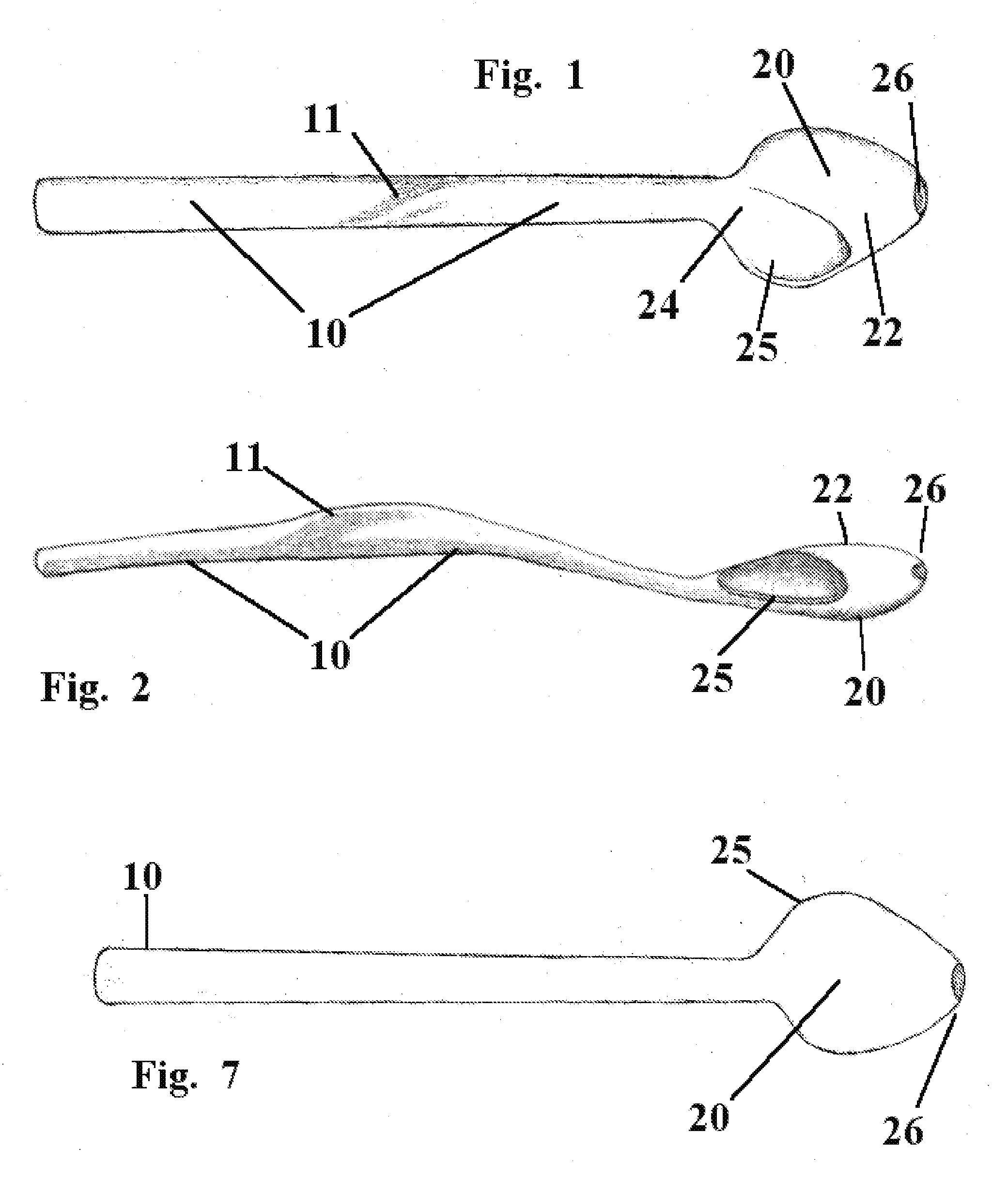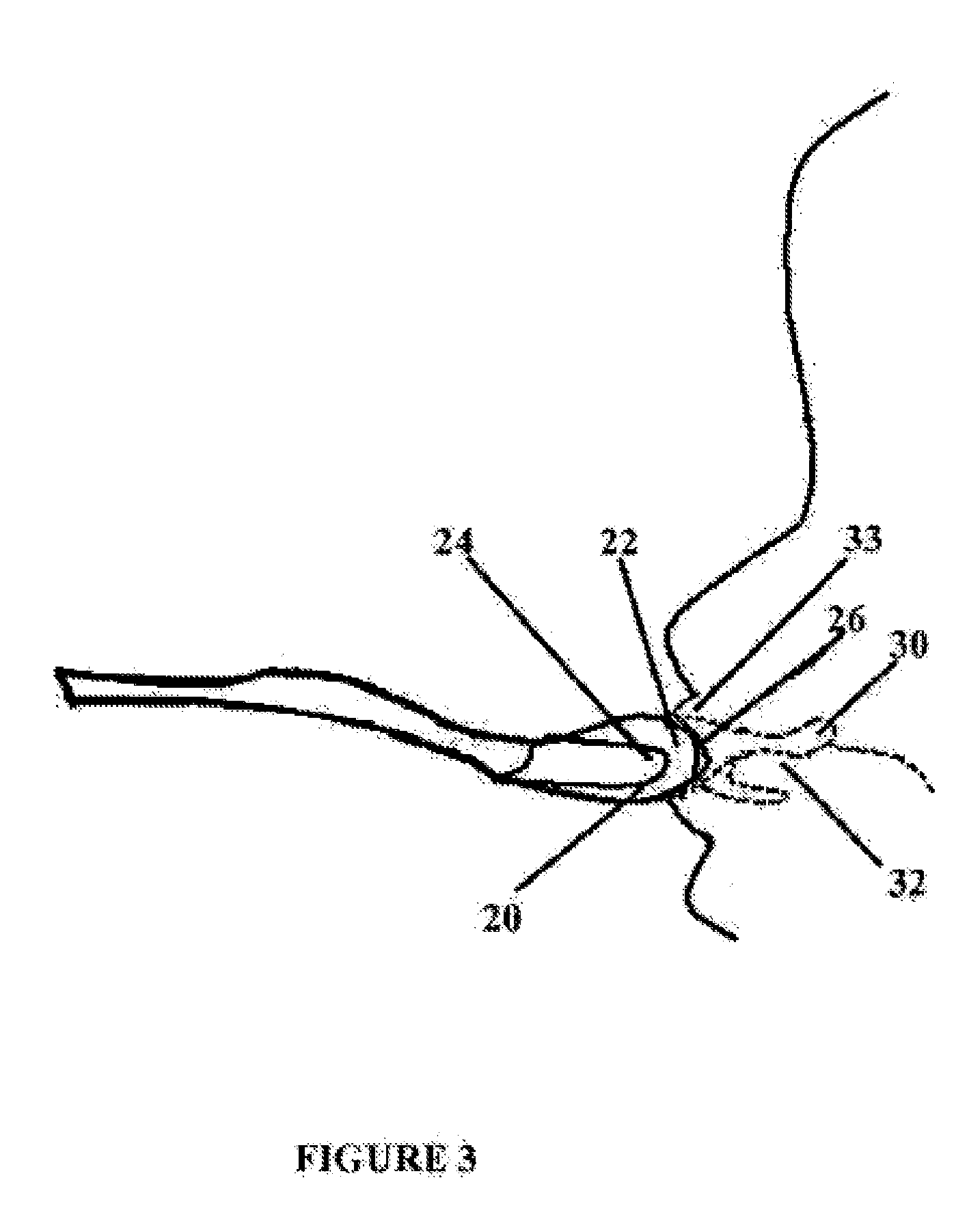[0011] It is desirable to provide a utensil that is of an inexpensive and uncomplicated design. The present invention employs a utensil that is designed for inexpensive manufacture and easy use by consumers, without complicated instructions or part assembly. The simplicity of the utensil of the present invention allows it to be easily provided in various sizes for different ages and mouth sizes. A preferred size for infants is a spoon bowl that holds from 6 to 15 milliliters of the semi-liquid food, medicine, or other nutrient being fed. The utensil of the present invention can be manufactured in certain sizes for the administration of specific dosages of medicine.
[0012] It is also desirable is to provide a utensil that is safe for an infant. The bowl of the spoon in the present invention may be made of materials, or coated for durability with materials, that can be repeatedly sterilized without breaking down, or for safety it may be comprised of or coated with materials that are heat-resistant or that change color when exposed to heat so as to indicate a high temperature. The entire utensil is a single integral piece for safety during the feeding process, preventing separation of small parts that could be swallowed.
[0013] It is also desirable to provide a utensil that increases feeding efficiency and reduces expulsion of food from the mouth during an infant's transitional feeding stage from bottle to spoon. In the utensil of the present invention, semi-liquid food is collected into the larger opening at the posterior of the spoon bowl by drawing the spoon through food in a dish or jar. The posterior opening is specially configured in a spatula-like shape for guiding food into the opening and making collection of the food easier. The front portion of the spoon bowl covered by the enclosing shield is then placed into the child's mouth, providing full circumferential contact with the child's mouth. In other words, as the child closes its lips around the front part of the spoon bowl and enclosing shield, complete contact is achieved between said utensil and both the upper and lower lips, creating a seal around the anterior opening of the utensil. The anterior of the spoon is specifically shaped as a depressed nipple. Its function relies on the infant's ability to begin the swallow by controlling the tongue and lips, forcing food to enter through the small opening created by the tongue and lips. When the seal on the anterior of the spoon bowl is in effect, the natural upward and forward movement of the child's tongue works to reduce air pressure within the oral cavity, thereby drawing the semi-liquid food from within the unpressurized cavity of the utensil into the rear of the child's mouth cavity. Thus, the food is released from the spoon into the rear of the child's mouth as the child engages in the natural feeding reflex, or suction. As the food is being moved into the back of the mouth, the child's lips remain sealed on the spoon bowl and enclosing shield. The spoon can then be removed from the mouth because the food has already been enveloped by the tongue and swept to the rear of the child's mouth, reducing and even eliminating the expulsion of food from the mouth. With the spoon removed, the child's mandible is able to close so as to complete the natural swallowing reflex.
[0014] It is also desirable to reduce air intake during the feeding process. Once a child sucks the food into the oral cavity, the spoon can be removed because the food is in the rear of the child's mouth cavity. The child can then complete the natural swallowing reflex by closing the mandible, sealing of the pharynx, and protecting the trachea. Because the spoon has been removed at this point, the swallowing action is completed without the introduction of air at the front of the oral cavity. The utensil of the present invention eliminates the need for repeated introduction of the spoon into the child's mouth to prevent expulsion of the food or to assist the child to move the food into the rear of the mouth cavity. In the absence of excess air, the food moves smoothly past the epiglottis and through the cricopharyngeal sphincter into the esophagus. The result is that less air is introduced into the digestive tract, reducing the occurrence of gastroesophageal reflux and gastrointestinal distress.
[0015] It is also desirable to provide a spoon that facilitates the feeding process. For this reason, the handle of the utensil of the present invention has been specially designed with a diagonal ridge to facilitate gripping it with the thumb and forefinger, such that the side of each digit is placed against opposing sides of the ridge. In addition, the anterior edge of the spoon is designed with a straight edge for easier collection of food that misses the infant's mouth during the feeding process. A straight edge at the anterior tip of the spoon has been shown in development to be more useful in scraping food off of an infant's face.
 Login to View More
Login to View More  Login to View More
Login to View More 


